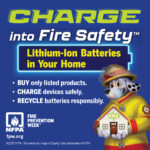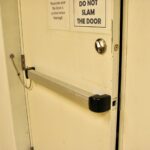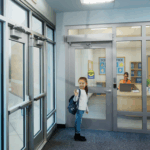Last month I posted some information about how the IBC addresses delayed egress and controlled egress applications. Several people asked if I would expand this to include NFPA 101, and it will be published in an upcoming issue of Doors & Hardware. This is not as easy as you might think…sometimes I read something one way and someone else reads it another, or my wording may not be quite right. And just looking at the same code sections for hours can make my eyes glaze over.
So here’s the deal. I’ve officially reached the point where I can’t look at this any more without going over the edge. I would really appreciate your help – whether you want to glance through it and look for typos, find something I haven’t explained very well, or you want to get your code books out and dig in. For the first 10 people who find a mistake that nobody else has found, I’ll send you a $25 Amazon.com gift card by email (limit – one gift card per person). Send me a list of any mistakes you find to help ensure that you have included a unique error that hasn’t already been found. I guarantee you’ll learn something in the process!
The table is too wide for me to paste here, so you can download it by clicking this link. Happy Hunting!
Just leave a reply below with any mistakes you find!
You need to login or register to bookmark/favorite this content.





Under ibc
Fire alarm activation, loss of power
Use wording from the book “require restraint or containment”
So it does not sound like it can be in any psychiatric setting
Looks like 101 requirements are good. I did not check all the occupancy type chapters.
I was wondering where you were getting the puh/pull terms in the IBC columns. I see now it comes out of 101.
I am wondering if that should be deleted from IBC, since it is not worded that way in IBC.
I hate the pull, especially when you think it should be a “push” and there is no wording on the handle.
Other than that looks great
Just a question some “fire exit hardware” is listed for these uses?
Yes, there is fire exit hardware that is listed for delayed egress and controlled egress – the Von Duprin Chexit is one such device.
The 2015 IBC has the same language as NFPA 101 for the sign except it’s written in 2 separate paragraphs for push and pull:
A sign shall be provided on the door and shall be located above and within 12 inches (305 mm) of the door exit hardware:
6.1. For doors that swing in the direction of egress, the sign shall read: PUSH UNTIL ALARM SOUNDS. DOOR CAN BE OPENED IN 15 [30] SECONDS.
6.2. For doors that swing in the opposite direction of egress, the sign shall read: PULL UNTIL ALARM SOUNDS. DOOR CAN BE OPENED IN 15 [30] SECONDS.
6.3. The sign shall comply with the visual character requirements in ICC A117.1.
Exception: Where approved, in Group I occupancies, the installation of a sign is not required where care recipients who because of clinical needs require restraint or containment as part of the function of the treatment area.
I’m not sure if this is a mistake, but under 2015 NFPA 101/Controlled Egress column and in the row ‘Maximum Quantity of Devices” row, did you intend to indicate locking devices “per door” or was that supposed to be “per egress path” like under the IBC columns? I would be surprised with having multiple devices per door.
On a side note, are you running into many jurisdictions that are enforcing NFPA 101 2015? Would it be prudent to at least mention where Medicare/Medicaid and The Joint Commission (plus any other national agencies) are at with building codes and life safety code enforcement?
I was surprised by that too…101 says: “Only one locking device shall be permitted on each door.” I didn’t see a limit on the number of doors with these locks in an egress path.
I haven’t seen many jurisdictions adopting 101-2015 yet, but I usually talk about the most current edition and mention changes from recent previous editions. CMS and the Joint Commission are moving to the 2012 edition of NFPA 101 but as far as I know they have not set a date.
– Lori
Nicely done, Lori!!!
Wish I had the kind of time it will require to assist you.
Too funny. 🙂
Me too! 🙂
A lot of great work here Lori! I really like the chart format. It is easy to read and flows well. Row 4 – Use Groups Where Application Is Allowed is very informative. I found relatively trivial stuff. See below.
Alzeimers to Alzeimer’s – E4
“Required where” is double spaced between the two words – E11 & E12
I will read it again tonight – right now I have a kid going – “Dad, Dad, Dad, Dad, DAAAAAD.” 🙂
Thanks! Trivial is good! Let me know if you find anything else!
– Lori
Ok reread IBC and see the push/ pull
Thanks
We will adopt the 2015 IBC in 2016 and will adopt 2015 101 by reference
A couple of questions:
1) Pls explain why would IBC restricts Delayed Egress Device on Educational occupancy, while NFPA allows?
2) Max qty of Delayed Egress Device per door – IBC says one per egress path, NFPA – ? (you have mentioned ‘Refer to occupancy chapter limitations above’, but at D4 the question of Max Qty of DA dev is not answered). Pls clarify.
Hi Khozema –
I wasn’t involved in code development way back when delayed egress was added to the codes, so I’m not sure why the IBC is different from 101 with regard to the occupancies where delayed egress locks are allowed. I do know that we submitted a code change proposal for the 2018 IBC that would allow delayed egress locks to be used in Educational occupancies, to try to address the problem of students leaving school. We won’t know for a while yet whether the change will be approved. With regard to the number of delayed egress devices per egress path, 101 limits the delays to 1 per escape path for Lodging and Rooming Houses (mentioned in D4) but I didn’t see any limits in the other occupancy chapters other than a few limits as to what type of doors they can be used on.
– Lori